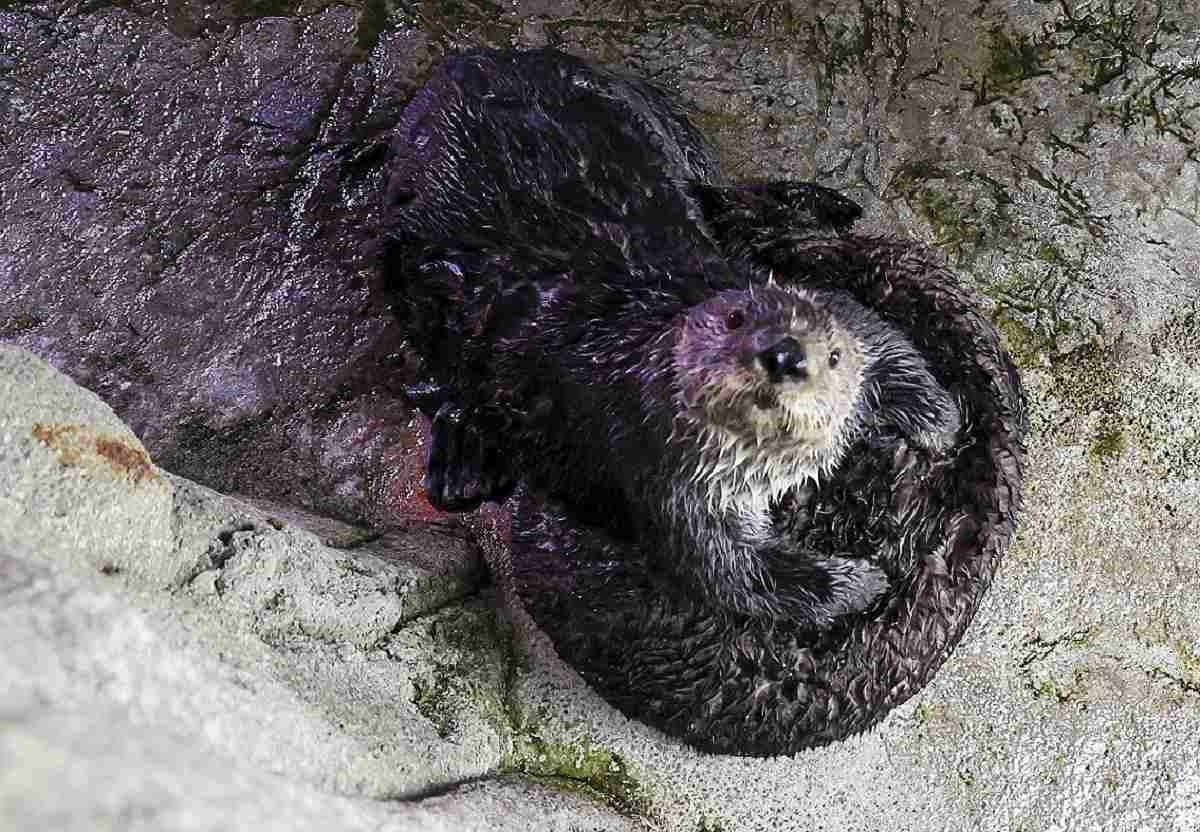
A sea otter looks up, at the Aquarium of the Pacific, in Long Beach, Calif., on April 11.
16:25 JST, April 25, 2024
LONG BEACH, Calif. (Reuters) — Every year, around 10 to 15 sea otter pups are found stranded off the California coast, often due to storms that separate mother and offspring.
The Aquarium of the Pacific in Long Beach is partnering with the Monterey Bay Aquarium to pair pups with surrogate sea otter mothers with the hope of teaching them life skills and returning them to the wild.
As part of the program, the aquarium has successfully bonded their first surrogate mom, called Ellie, and a pup.
“That mom is going to teach them all of the behaviors that we cannot teach, being people,” said Megan Smylie, the sea otter program manager at the Aquarium of the Pacific.
“That adult female will start to mimic behaviors that the pup should learn, will help it groom, will help it forage, will help it teach prey manipulation, how to open up shells and anything that they would need to know that humans are unable to teach them,” Smylie added.
California sea otters are a protected species. After being relentlessly hunted for their unique fur — they have the densest hair of any animal with up to a million hairs per square inch (6.45 square centimeters) — they were thought to be extinct until a colony of 50 was found off the coast of Big Sur in the 1930s.
Now, the numbers are up to around 3,000 but more are needed not only for the species’ survival but also to protect California’s near-shore ecosystems.
“They are a critical sort of predator in that system that keeps herbivores like sea urchins in check so that sea urchins don’t overpopulate and take out kelp forests and eel grass beds, as an example,” said Brett Long, a senior director at the Aquarium of the Pacific.
The sea grass and kelp ecosystems are credited with creating biodiversity, protecting against climate events and are a powerful tool in carbon sequestration, Smylie said.
Sea otters may be super cute and cuddly, but Long also says they are very territorial and are “just a wolverine in the water.”
And their eating habits are pricey, as they consume 25% of their bodyweight every day in restaurant-quality seafood. So a 20-kilogram otter eats 4.5 kilograms-5.4 kilograms of seafood a day.
That means that feeding an otter costs the aquarium $40,000 a year and demands constant fundraising.
The two aquariums have rescued eight stranded pups and hope other organizations can join the effort to increase the population in the wild and protect the California shore ecosystem.
“This is a bigger purpose,” said Long. “This is a higher challenge. So we invest and we invest a lot but we’ve all now learned and appreciate, boy, you see that juvenile otter survive out in the wild. That feels incredible.”
"Science & Nature" POPULAR ARTICLE
-

Genome Study Reveals Milestone in History of Cat Domestication
-

Big Leap in Quest to Get to Bottom of Climate Ice Mystery
-

Japan Set to Participate in EU’s R&D Framework, Aims to Boost Cooperation in Tech, Energy
-

Paws on Parade: Nairobi’s Dogs Dazzle at ‘Pawchella’
-

Japan’s H3 Rocket Failed in Latest Launch, Says Official
JN ACCESS RANKING
-

Tokyo Economic Security Forum to Hold Inaugural Meeting Amid Tense Global Environment
-

Keidanren Chairman Yoshinobu Tsutsui Visits Kashiwazaki-Kariwa Nuclear Power Plant; Inspects New Emergency Safety System
-

Imports of Rare Earths from China Facing Delays, May Be Caused by Deterioration of Japan-China Relations
-

University of Tokyo Professor Discusses Japanese Economic Security in Interview Ahead of Forum
-

Japan Pulls out of Vietnam Nuclear Project, Complicating Hanoi’s Power Plans






















